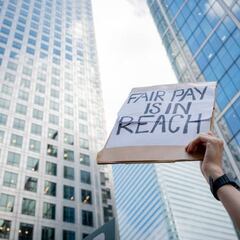How will the new deal with the rail unions improve conditions for railroad workers?
A tentative agreement has been found between workers and companies in one of the most important sectors of the US economy. Will the deal be accepted?

The White House has lauded an agreement between the rail companies and unions after twenty hours of negotiations averted the first rail strike in 30 years.
Workers are set to receive a big pay increase as well as a $1,000 bonus, improving the draconian working conditions that have contributed to thousands leaving the sector in recent years.
Why were workers going to strike?
There are plenty of problems with the state of work on the railways in the US.
In one Facebook group for rail workers, a union member explained how they are expected to work on weekends and only receive “30 days off all year.” Workers are on call 24/7 unless they have arranged for a day off, which makes taking time off for health reasons or other emergencies virtually impossible. In comparison, most other workers get around 120 days off a year, including holidays and weekends.
Rail workers, additionally, are not entitled to any sick days. The inclusion of at least fifteen paid sick days a year has been a major sticking point throughout the negotiations. Currently, workers who try and take sick leave, which is unpaid, are disciplined, and even fired for taking time off for medical emergencies. This was a particular problem during the covid-19 pandemic, with so many Americans falling ill with the highly contagious virus.
Railroad workers have been without a contract for 3 years.
— More Perfect Union (@MorePerfectUS) September 14, 2022
They’re on call 24/7, work 80+ hour weeks, have zero sick days.
Their whole lives are dictated by the whims of the rail carriers. pic.twitter.com/1DIbjtbCsm
These conditions have led to a fall of 40,000 jobs in the industry between November 2018 and December 2020. The workforce is only 15 percent of the size it was in the 1950s and is 70 percent of the size it was back in 2016. While the workforce has been sinking, profits have been booming. Railroad companies have paid out $196bn in stock buybacks and dividends to shareholders since 2010.
After two years of contractual disagreements between rail companies and unions, a Presidential Emergency Board was created back in July to arbitrate between the two sides. The Railway Labor Act, a law designed to avert rail strikes, allows for the federal government to develop a binding agreement, which Congress has the power to make the binding. If such a Congressional action is taken, workers lose their power to strike, even if members vote down the contract. According to research from the Association of American Railroads, which represents the interests of the rail companies, a strike could cost $2 billion a day.
It’s not just US rail workers feeling the pinch. Staff in rail unions in the UK have been on strike multiple times this summer over pay and conditions. The most recent strike by the National Union of Rail, Maritime and Transport Workers (RMT) was postponed due to the death of the Queen. The union’s most recent rally was attended by US Senator Bernie Sanders, who discussed the similar problems facing US and UK workers as the pandemic recedes.
Risk of a strike still looms if deal rejected
With the first day of strikes set for Friday, it was all hands on deck for an agreement to be reached between rail bosses and workers’ union representatives. Late Wednesday night, President Biden said that negotiators had reached a “tentative” deal which would be sent to the unions on Thursday.
Many are skeptical that rail workers will accept the deal as the only compromise made in relation to paid sick leave was for companies to allow workers to take one day of paid sick leave per year. While, a positive step, it may not be enough that medical emergencies and procedures will no longer leave workers open to dicisplanary action should they need more than one day to recover.
Furthermore, a large pay increase of 24 percent by 2024 would be implemented, including a 14 percent increase from day one alongside $1,000 a year bonuses. This rise is a major win and would secure pay long-term unless inflation is not kept in check.
MORE DETAILS:
— Lauren Kaori Gurley (@LaurenKGurley) September 15, 2022
Workers will receive voluntary assigned days off AND a single additional paid day off. (They previously did not receive sick days.)
+ The agreement provides members with ability to take unpaid days for medical care without being subject to attendance policies.
However, the last set of conditions was rejected by eighty percent of the union members, so it will still take a significant amount of effort for the deal to be accepted. Sick days were the primary concern for the workers though the new plan only allots one paid day of sick leave with all other days unpaid.
Related stories
“The solidarity shown by our members, essential workers to this economy, who keep America’s freight trains moving, made the difference in our obtaining an agreement with provisions that exceeded the recommendations of the Presidential Emergency Board,” said Jeremy Ferguson, president of SMART Transportation Division, and Dennis Pierce, President Brotherhood of Locomotive Engineers and Trainmen. Their joint statement represents the views of two of the unions in support of the deal.
The strike for Friday is averted, but if workers were to reject the latest plan, then a strike could be back on as soon as next month.

